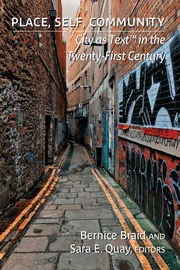Table Of Contentfrom Place, Self, Community— pl ppllaaccee,, sseellff,, ccoommmmuunniittyy
a
c
e
“Place, Self, Community: City as Text™ in the Twenty-
,
s CCiittyy aass TTeexxtt™™ iinn tthhee
First Century focuses on the power of structured e
l
explorations (reflective practices ranging from debriefs f
,
c TTwweennttyy--FFiirrsstt CCeennttuurryy
and discussions to reflective writing and discussions) and
o
m
on forms of immersion in place. This monograph explores
m
the inherent integrative learning capacity to generate a
u
n
sense of interconnectedness, of self-in-context, which finds
i
t
expression in professional practices that endure long after y
the original experiential adventure is over. It explores the
ways that this pedagogical strategy affects professors as
well as students, and it examines instances of experiential
learning outcomes that illustrate the power of integrative
learning to produce social sensitivity and engagement,
especially when that integrating includes unscripted, raw
experience in the service of making sense of complex
settings. An emphasis on developing antennae for context
and lens distinguishes this approach to learning.
Contributors include individuals whose professional
lives track in some way back to foundational experiences
that illustrate linkages between early immersion and later
n
social engagement. Authors represent social sciences,
c
humanities, and science backgrounds and applications. They h
c
include the voices of alumni of NCHC’s Honors Semesters, m
o
professionals who have used this approach in diverse
n
settings, and commentators on both process and practice.” o
g
r
—Bernice Braid
a
p
h BBeerrnniiccee BBrraaiidd
aanndd
s
e
r SSaarraa EE.. QQuuaayy,,
i eeddiittoorrss
e
ISBN: 978-1-945001-13-0 s
place, self, community
City as Text™ in the
Twenty-First Century
place, self, community
City as Text™ in the
Twenty-First Century
Bernice Braid
Edited by
Sara E. Quay
and
Series Editor | Jeffrey A. Portnoy
Perimeter College, Georgia State University
National Collegiate Honors Council
Monograph Series
Copyright © 2021 by National Collegiate Honors Council.
Manufactured in the United States
National Collegiate Honors Council
Knoll Suite 250
University of Nebraska-Lincoln
440 N 17th Street
Lincoln, NE 68588
www.nchchonors.org
Production Editors | Cliff Jefferson and Mitch Pruitt
Wake Up Graphics LLC
Cover and Text Design | 47 Journals LLC
Cover Image | Marcus Loke (Unsplash.com)
International Standard Book Number
978-1-945001-13-0
table of contents
Acknowledgments............................................vii
Introduction
Place, Self, Community:
City as Text™ in the Twenty-First Century...........................ix
Bernice Braid
PART 1:
Theory and Practice of City as Text™
Brain Activity and Experiential Learning............................3
Paul Witkovsky
Lost in Learning:
Mapping the Position of Teacher in the Classroom and Beyond.........21
Susan M. Cannata, Jesse Peters, Alix Dowling Fink,
Edward L. Kinman, JoEllen Pederson, Phillip L. Poplin, and
Jessi B. Znosko
Learning from the Land:
Creating Authentic Experience-Based Learning that
Fosters Sustained Civic Engagement.............................47
Ted Martinez and Kevin Gustafson
Integrating Dynamic Systems Theory and City as Text™ Framework:
In-Depth Reflections on ‘Lens’....................................59
Ron Weerheijm and Patricia Vuijk, with a contibution from
Bernice Braid
PART 2:
Self-in-Context through Integrative Learning
Reflections on the 1978 United Nations Semester....................91
Dawn Schock
v
Table of Contents
Engaging with the World:
Integrating Reflections and Agency...............................101
Will Daniel
The Merits of Applied Learning..................................109
Michael Rossi
Committee as Text.............................................117
Mimi Killinger
PART 3:
Designing City as Text™ Integrative Learning Experiences
Connecting to Place:
A City as Text™ Assignment Sequence............................123
Sara E. Quay
Reading the Local in the New Now:
Mapping Hidden Opportunities for Civic Engagement in the
First Virtual City as Text™ Faculty Institute.......................145
Season Ellison, Leslie Heaphy, Amaris Ketcham, Toni Lefton,
Andrew Martino, and Sara E. Quay
Doubling Back on the City as Text™ Walkabout...................167
Gabrielle Watling
Transforming Community-Based Learning
through City as Text™........................................173
Jean-Paul Benowitz
Conclusion
Acts of Interpretation:
Pedagogies of Inquiry..........................................185
Bernice Braid
About the Authors...........................................200
About the NCHC Monograph Series............................205
vi
acknowledgments
The editors would like to recognize the many people who make City
as Text™ possible: the hundreds of CAT participants from the 1970s
through the present who continue to inspire this work; the dedicated
and creative members of the Place as Text Committee of the National
Collegiate Honors Council (NCHC) who make CAT possible; and the
NCHC Publications Board, especially Jeffrey Portnoy and Ada Long, for
seeing this monograph through to publication and ensuring its excellence.
Above all, to the hundreds of students who have, over the decades since
NCHC Honors Semesters started, contributed to our deep learning about
how all of us see and make sense of what we see as we explore the world.
Thank you!
Bernice Braid
Sara E. Quay
vii
introduction
Place, Self, Community:
City as Text™ in the Twenty-First Century
Bernice Braid
Long Island University Brooklyn
The contradictions are self-evident, but then, cities are con-
tradictions with street lights, or else they are not cities at all.
—Adam Gopnik, 2019
Students and faculty who have designed or participated in City
as Text™ (CAT) know well that every place they have explored
has organized itself into areas, events, and interactions that either
immediately or eventually make sense out of contradictory bits of
information. This realization might be more self-evident in urban
walkabouts but has bubbled up to consciousness in rural settings,
forests, jungles, neighborhoods, and even a shopping mall explored
at a National Collegiate Honors Council (NCHC) conference.
What lies beneath the surface, we tell our explorers, is what
we want to expose to our gaze and unmask for our deeper con-
sideration. What we suspect about “place” reveals what makes it
unique: the particular contradictions that reveal themselves only
if we look more carefully, critically, and sensitively at what hides
them. These underlying contradictions are what we think about
when we consider a constellation of CAT questions about a place:
What does it feel like to live/be here? For whom/what? Under what
circumstances?
When we start to discuss our answers—and for explorers the
questions are always “ours” to begin with, for reasons that will
become apparent throughout this monograph—we begin to identify
several profoundly important elements of our activity: the matter of
whose lens—from what viewpoint—we are looking; in what context
ix

